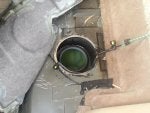200 ML320 with 202K miles. My issue:
- Fuel guage has not worked for past few years.
- I simply reset the trip meter after every fill up.
- Wife is tired of that approach, so I need to fix it.
- After reading EVERY post, it appears there are four primary causes
1> Fuse 5 for cluster. Tried, did not work
2> Connector in rear driver side wheel well. Tried, did not work
3> Cluster. Haven't tried
4> Fuel Sender Unit Corrosion. Took out the back seat, lifted carpet, removed pump cover. The pump was replaced last year. All appeared clean inside, but i removed the sender unit connector, cleaned the 4 silver pins (male) and cleaned the connector (female) with electrical parts cleaner. Waited 10 minutes for area to dry, used compressed air to make sure it was dry. Turned key to #2 position. Fuel guage lifted to 1/4 tank, wich was correct!!!
Put back fuel pump cover, replaced carpet and seat. Connected red wire below seat (not sure what this is?), patted self on back. Turned on car to drive into garage. The fule guage was pinned at E. Unbelievable!!! What could have changed? I didn't even touch the connector after it worked. Could the carpet be putting pressure on the wires surrounding the fuel pump and shorting them? What else could it be?
What could have changed? I didn't even touch the connector after it worked. Could the carpet be putting pressure on the wires surrounding the fuel pump and shorting them? What else could it be?
Does anyone have the readings I should expect from the four silver pins if I attach a meter?
BTW, the overhead trip computer constantly reads 496 miles left, so I'm assuming the issue is with the sending unit and not the cluster as the sending unit is feeding both.
Spartacus
- Fuel guage has not worked for past few years.
- I simply reset the trip meter after every fill up.
- Wife is tired of that approach, so I need to fix it.
- After reading EVERY post, it appears there are four primary causes
1> Fuse 5 for cluster. Tried, did not work
2> Connector in rear driver side wheel well. Tried, did not work
3> Cluster. Haven't tried
4> Fuel Sender Unit Corrosion. Took out the back seat, lifted carpet, removed pump cover. The pump was replaced last year. All appeared clean inside, but i removed the sender unit connector, cleaned the 4 silver pins (male) and cleaned the connector (female) with electrical parts cleaner. Waited 10 minutes for area to dry, used compressed air to make sure it was dry. Turned key to #2 position. Fuel guage lifted to 1/4 tank, wich was correct!!!
Put back fuel pump cover, replaced carpet and seat. Connected red wire below seat (not sure what this is?), patted self on back. Turned on car to drive into garage. The fule guage was pinned at E. Unbelievable!!!
Does anyone have the readings I should expect from the four silver pins if I attach a meter?
BTW, the overhead trip computer constantly reads 496 miles left, so I'm assuming the issue is with the sending unit and not the cluster as the sending unit is feeding both.
Spartacus












